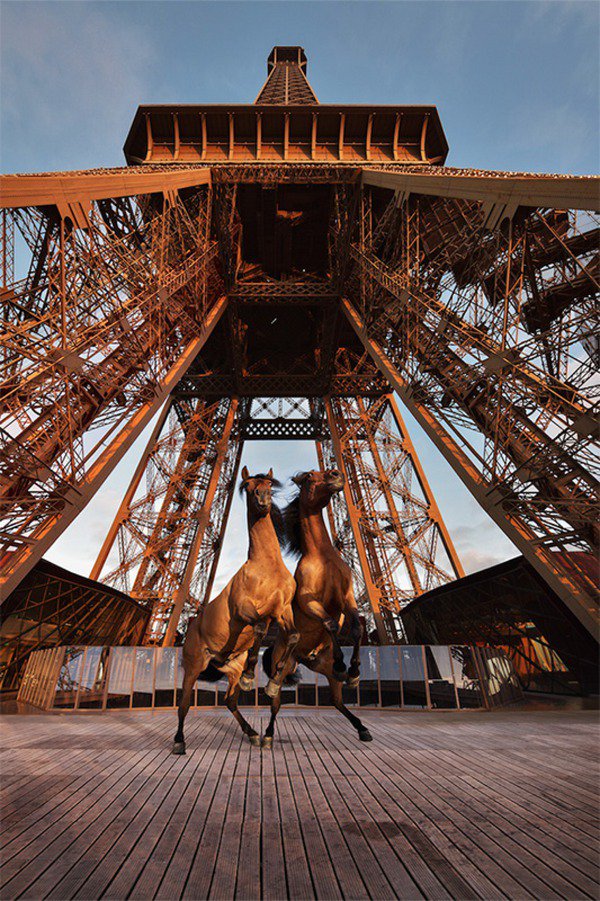Two Exhibitions
dal 3/6/2015 al 31/7/2015
Segnalato da
3/6/2015
Two Exhibitions
Galerie Emmanuel Perrotin, Paris
Paola Pivi presents 'Yee-Haw' a new series of photographs with animals. Chung Chang-Sup with 'Meditation' propose pieces made between 1985 and 2005. Most of his works were created with hanji paper, made in a lengthy process using mulberry fiber, one of the most traditional Korean materials.

Paola Pivi: Yee-Haw
Yee-Haw, Paola Pivi’s ninth exhibition at Galerie Perrotin in the last
fifteen years, introduces a new series of photographs with animals.
Her diverse work, spanning performances to sculptures to large
installations, is punctuated over the years by her photographic
representations of animals in performative happenings; these are
her most renowned images.
A long way from unicorns and other chimeras, the animals that
Paola Pivi’s world are very real. Yet, set in their strange
, surroundings, they appear as a dream within reality, imbuing them with a mythological aura (ostriches or a donkey sailing on a small boat in the Mediterranean Sea, 84 goldfish swimming in bowls
and flying in a passenger airplane in New Zealand, different white
animals grazing in an Edenic land, alligators frolicking in whipped
or polar bears covered in multicolored feathers
posing during the inauguration of Galerie Perrotin in New York).
These images cast a new oneiric light over the world, viewed now
through the prism of fantasy, of a fabulous bestiary. They appear
to reveal a dimension that is a part of everyday life, which has only
by chance never occured before in front of someone’s eyes.
For this exhibition, Pivi brought four horses to the Eiffel Tower. The
animals seem to have found a new playground, an architectural
landscape made to their measure. Once again, Pivi revisits and
juxtaposes elements that are both familiar and archetypal into a
fantastic iconography.
----
Chung Chang-Sup: Meditation
Galerie Perrotin, Paris, presents the first French exhibition by South
Korean painter Chung Chang-Sup (Cheongju, 1927–Seoul, 2011),
a major figure of his country’s art scene. Made between 1985 and
2005, the pieces on show represent the artist’s late maturity. Chung
Chang-Sup worked in series, and the mixture of materials he affixed to
his canvases in early works led some to compare him to art informel
and matter painting. Most of his works were created with hanji paper,
made in a lengthy process using mulberry fiber, one of the most
traditional Korean materials.
Chung Chang-Sup graduated from the College of Fine Arts, Seoul
National University, Korea in 1951. His first paintings, executed in oil,
explored aspects of Western modernism, notably the question of form
as it was conceived by the Cubists and of materiality, as in the many
experiments of post-war art informel. But for all his interest in the West,
the artist also helped forge a new Korean artistic identity, breaking
free of Chinese and Japanese influence after the liberation of 1953.
In the 1970s, Chung Chang-Sup founded the Dansaekhwa group
with his contemporaries Lee Ufan, Chung Sang-Hwa, Ha Chong-
Huyn, Park Seo-Bo, and Yun Hyong-Keun. Also known as “the school
of white,” the group’s “meditative” aesthetic is said to have been
inspired by the restrained beauty and simple forms of the white
porcelain made during the Joseon period (1392-1910), illustrating
Korean Confucian ideas. Indeed, Chung Chang-Sup titled some of
his youthful works White Porcelain.
Members of the Dansaekhwa group practised monochrome using a
limited range of colours: white, black and beige, which is the colour
of the hanji paper used by Chung Chang-Sup after 1975, and which
gradually became his trademark. The Tak series from the 1980s -
which opens the show and is named after the mulberry paper utilized
by the artist - illustrates this point. Hanji provided the artist with a
material integrated into the support; it could also be used to create
delicate effects on the surface of the very dense application of the paper
that covered the surface of the canvas by making imprints within its
creases. In this way he could preserve the mobile trace of the gesture
and the vibrant impact of the creative act on the surface of the work.
In this series he reveals the pictorial space by edging his compositions
with a particularly dense zone of material in relief. His treatment of the
quadrangular, monochrome figures is, paradoxically, smoother, with
the effect of hollowing out the space in the centre of the work. The
border can be seen to represent the physical limits inherent to the
materiality of the world that is traversed in the art of meditation, just
as one traverses this initial plane to attain the pure space of painting.
The apparent simplicity of these compositions, sometimes said to
be inspired by minimalism, also question the infinite depth of the
painting, which is like an inner landscape. According to Yoon Jin-sup,
“His creations are placed within an ecological, cosmological and
terrestrial perspective which is diametrically opposed to the formalist
vision of Westerners.”
Image: Paola PIvi, Yee-Haw", 2015, Digital Print mounted on dibond and diasec, Photography by Hugo Glendinning, 219 x 180 cm / 86 1/4 x 70 3/4 inches
Press Contact:
Héloïse Le Carvennec, Head of Press & Communication, heloise@perrotin.com +33 1 42169180
Thomas Chabaud, Press Officer, thomaschabaud@perrotin.com +33 176210711
Opening reception: Thursday 4 June, 4-9pm
Galerie Perrotin
76 rue de Turenne, Paris
Tue - Sat 11am to 7pm



